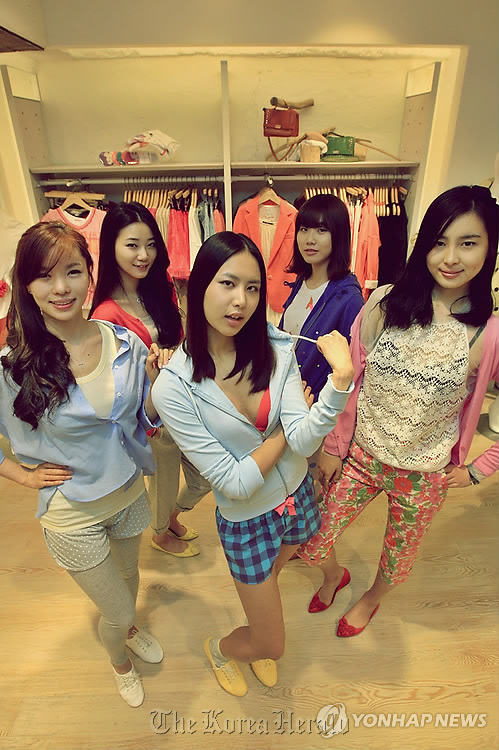Fast-fashion brands lead transition in Korea’s clothing retail industry
By Shin Hyon-heePublished : April 17, 2012 - 18:14
Before sunrise on March 8 in Myeong-dong, one of Seoul’s top shopping districts, dozens of people lined up in front of an H&M store.
Some had spent the night on the street.
They were waiting to get limited edition clothing from a collaboration between H&M’s specialty retailer and premium brand Marni. Freezing weather was not their first concern.
The “Marni at H&M” edition went on sale that day globally and were sold out in Korea a few hours after the store opened. According to the companies, Korea sold out in the shortest time worldwide.
Some had spent the night on the street.
They were waiting to get limited edition clothing from a collaboration between H&M’s specialty retailer and premium brand Marni. Freezing weather was not their first concern.
The “Marni at H&M” edition went on sale that day globally and were sold out in Korea a few hours after the store opened. According to the companies, Korea sold out in the shortest time worldwide.

In November, global specialist private-label apparel (SPA) brand Uniqlo launched a flagship store in Myeong-dong. There were more than 1,000 customers waiting at its opening and it took over 50 minutes to enter, even though the shop has 4,000 square meters of space. Uniqlo set a sales record of over $1.7 million in the first three days from this single store ― the figure is greater than the annual sales of many brands.
Global SPA brands are enjoying their peak moment in Korea. Well known for Zara, Spain-based Inditex launched an additional five brands. Hollister from the U.S., Topshop from the U.K. and many more global SPA brands have plans to launch or expand in Korea. Japan’s Uniqlo opened Asia’s largest store at the heart of Myeong-dong. To compete with them, leading Korea fashion houses are keen to launch their own SPA brands. Among them are 8 Seconds by Cheil Industries, a subsidiary of Samsung Group, as well as Mixxo and SPAO by E-Land.
SPA is like a single course meal
Satisfying contemporary consumer trends with the concept of one-stop shopping, SPA brands prevail globally. However, compared to other countries, their speed of growth in Korea is tremendous.
Even during the global economic crisis, major SPA brands were getting ready for aggressive expansion in Korea. What are major driving forces behind these SPA brands’ swift emergence in the Korean fashion industry?
One staff member at an SPA brand’s expansion department said that SPA was “like a single course meal.” Department stores are like a course meal, where you can see many products displayed altogether but you need to shop at several places to buy them. SPA brands have everything for men and women, young and old, just like a single course meal ― the Korean style of dining.
Forming symbiotic relationship between shopping malls and SPA brands
SPA brands, many of which originated from Europe, have expanded their forays into Hong Kong, Singapore, Japan and then Korea. There could be some differences in market size, consumption power and more, but sales of some SPA flagship stores in Myeong-dong are similar to those on Canton Road in Hong Kong, a famous shopping destination.
I believe the delay in SPA brands’ inroads into Korea stems from unique local distribution networks rather than consumption power. SPA brands become more efficient once the shop gets bigger, so they tend not to work with department stores that increase sales by splitting the space into smaller sections.
So it is difficult for SPA retailers to expand in a market where department stores are dominant and high-street shops require high rents and security deposits.
Even in Myeong-dong and the Gangnam Station area with the country’s largest floating populations, most buildings are not big enough to accommodate SPA brands. There are still many SPA brands anxious to find good-sized stores before launching here.
Since late 2000, however, this trend has changed. Some brands launched in Myeong-dong with a shop size of more than 1,600 square meters. Foreign investment companies bought shopping malls, namely M Plaza and Noon Square among others, renovated and leased them to SPA brands. These stores became their first branches in Korea.
Their tremendous success triggered a rapid expansion of SPA brands in Korea, raising retail investment prospects for foreign investors and signaling a new era of shopping malls. Ever since, many newly developed shopping malls have been vying to court SPA brands as their anchor tenant and thus creating a symbiotic relationship.

By Dan Kim
Senior manager for retail transaction, Cushman & Wakefield Korea
The article was contributed by Cushman & Wakefield Korea, which consults corporate clients on leasing, sales and management services. ― Ed.







![[KH Explains] Hyundai's full hybrid edge to pay off amid slow transition to pure EVs](http://res.heraldm.com/phpwas/restmb_idxmake.php?idx=644&simg=/content/image/2024/04/18/20240418050645_0.jpg&u=20240419100350)






![[From the Scene] Monks, Buddhists hail return of remains of Buddhas](http://res.heraldm.com/phpwas/restmb_idxmake.php?idx=652&simg=/content/image/2024/04/19/20240419050617_0.jpg&u=20240419175937)

![[KH Explains] Hyundai's full hybrid edge to pay off amid slow transition to pure EVs](http://res.heraldm.com/phpwas/restmb_idxmake.php?idx=652&simg=/content/image/2024/04/18/20240418050645_0.jpg&u=20240419100350)

![[Today’s K-pop] Illit drops debut single remix](http://res.heraldm.com/phpwas/restmb_idxmake.php?idx=642&simg=/content/image/2024/04/19/20240419050612_0.jpg&u=)